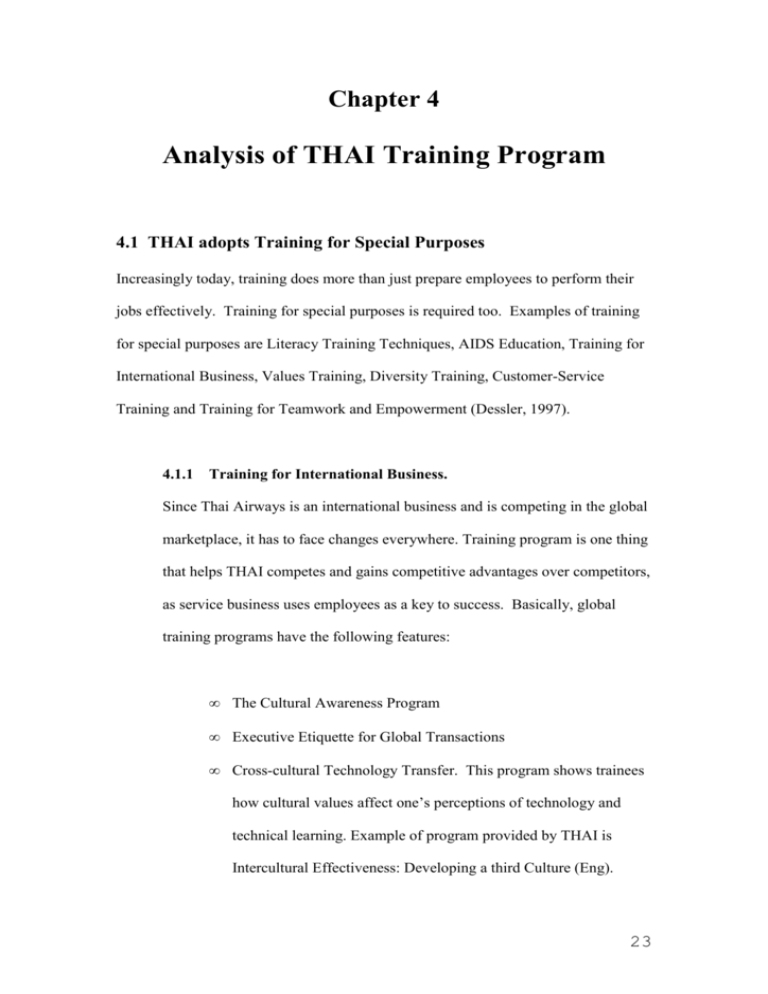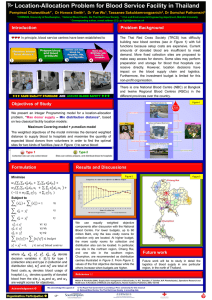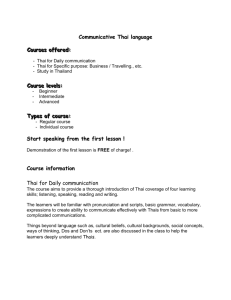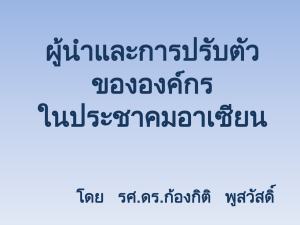Chapter 4: Analysis of Training programs
advertisement

Chapter 4 Analysis of THAI Training Program 4.1 THAI adopts Training for Special Purposes Increasingly today, training does more than just prepare employees to perform their jobs effectively. Training for special purposes is required too. Examples of training for special purposes are Literacy Training Techniques, AIDS Education, Training for International Business, Values Training, Diversity Training, Customer-Service Training and Training for Teamwork and Empowerment (Dessler, 1997). 4.1.1 Training for International Business. Since Thai Airways is an international business and is competing in the global marketplace, it has to face changes everywhere. Training program is one thing that helps THAI competes and gains competitive advantages over competitors, as service business uses employees as a key to success. Basically, global training programs have the following features: • The Cultural Awareness Program • Executive Etiquette for Global Transactions • Cross-cultural Technology Transfer. This program shows trainees how cultural values affect one’s perceptions of technology and technical learning. Example of program provided by THAI is Intercultural Effectiveness: Developing a third Culture (Eng). 23 • International Protocol and Presentation • Cross-cultural Training and Orientation. Topics here include cross-cultural communication and business skills, practical approaches to managing culture shock and adjusting one’s lifestyle, stress management, daily life in the host country, spouse’s and family’s concerns, area studies, and repatriation procedures. Example for THAI training program is Cross-cultural Management. • Business Basics for the Foreign Executive. • Language Programs. Include translation, interpretation, crosscultural training, and consulting on language-related needs. Example of training program provided by THAI is Interpersonal Communication Skills (Eng). • Language Training. Provide various language training by certified instructors. 4.1.2 Values Training. Many training programs today are aimed at educating employees about the firm’s most cherished values and convincing employees that these should be their values as well. Examples of training programs provided by THAI are Orientation Course and Introduction to Airline Business. 24 4.1.3 Diversity Training THAI is also an organization with an increasingly diverse work force, so it is important to implement diversity training programs. Benefits of diversity training are to create a better sensitivity among supervisors about the issues and challenges women and minorities face in pursuing their careers. Diversity training creates better cross-cultural sensitivity among supervisors and non-supervisors with the aim of creating more harmonious working relationships among a firm’s employees. THAI also implements many diversity-training programs, one of them is Psychology of Human Relations. 4.1.4 Customer-Service Training The basic aim here is to train all employees to treat the company’s customers in a couteours and hospitable manner. The saying “The customer is always right” is being emphasized by countless service companies today, including THAI. Example of training programs provided by THAI are Developing Skillful Services, Customer Service Excellence, Public Relations for Service Excellence. 4.1.5 Training for Teamwork and Empowerment An increasing number of firms today use work teams and empowerment to improve their effectiveness. Like THAI, it adopts teamwork as a value and organize work teams empowered to get the job done, which means employees have authorization and ability to do their jobs. Another word is called ‘Worker involvement programs’ 25 aim to boost organizational effectiveness by getting employees to participate in the planning, organizing, and general managing of their jobs. However, empowering employees, either individual or teams requires extensive training. Extensive training is required to ensure that employees have skills to do the job. THAI considers teamwork approaches as a critical aspect and working in team can get jobs done faster and employees feel that they belong to the company success. Examples of training programs provided by THAI are Team Development Workshop, Group Behavior. 4.2 Strategic involvement of Training and Development THAI offers totally 52 training programs categorized by four levels of management, Clerical level, Supervisory Level, Managerial Level and Executive Level. The reason why THAI offers a lot of training programs for employees is mainly to improve business performance in order to compete in global competition, competitors are other airlines from any country. THAI also looks at cost and benefits of implementing training programs. The results come that benefits of performance increased are greater than cost of training THAI has to pay. 4.2.1 Financial Position • Net Profit for the year 1998 was 3,696,240,687 Baht, while that of the year 1997 THAI faced the loss of 25,202,587,572 Baht ( THAI, 1999). 26 • Total Operating Revenue was increased to 105,493 Million Baht in 1998 as compared to 84 Million Baht in 1997. • Total Revenues in 1998 was 109,504 Million Baht, an increase of 25% from 1997. • Total Expenses reduced from 112 Million Baht in 1997 to 104 Million Baht in 1998. • Non-Operating Expenses amounted 11,930 Million Baht in 1998, a decrease of 67.8% from 1997. • Outstanding Long-term liabilities in 1998 decreased of 4,844 Million Baht as compared to the previous year. • Cash and bank balances as of September 30, 1998, amounted to 3,948 Milion Baht, an increase of 718 Million Baht from the previous year. 4.2.2 Operations • Total passengers’ traffic for the fiscal year 1998 was 15,198,715 passengers, an increase of 20,873 persons. • Number of Aircraft increased from 76 in 1997 to 77 in 1998. • Number of personnel increased from 24,072 people in 1997 to 24,222 people in 1998. • Revenue Passenger/Kilometers increased from 2,391 Million from 1997 to 2,468 Million in 1998. • Revenue Ton/Kilometers increased from 4,466 Million to 4,585 Million from 1997 to 1998. 27 4.3 THAI develops Controlled Experimentation as Training Evaluation There are two basic issues to address when evaluating a training program. The first is the design of the evaluation study, in particular, controlled experimentation is used. Controlled experimentation is the best method used in evaluating a training program. In this method, both a training group and a control group (that receives no training) are used. Data is obtained both before and after the training effort in the group exposed to training and before and after a corresponding work period in a control group. In this way, it is possible to determine the extent to which any change in performance in the training group resulted from the training itself rather than from some organization wide change like a raise in pay. (Dessler, 1997). For THAI perspective, it is easy to see the different skills and abilities between the employees who have passed a training program as compared to the others who do not take it. Other evaluation methods that THAI uses are questionnaire for managerial and executive levels and paper and pencil test for clerical and supervisory levels. As for guest speakers, used for clerical and supervisory levels, exams conducted by that specific speakers and the results would come in percentage of learning. 28






